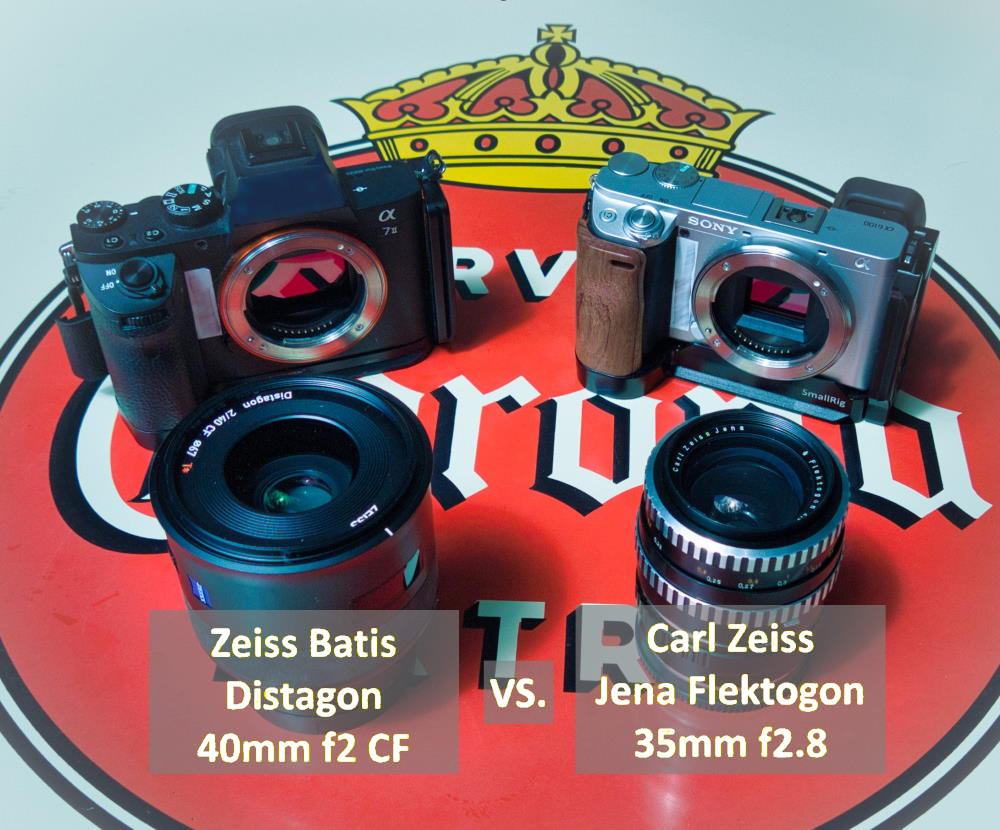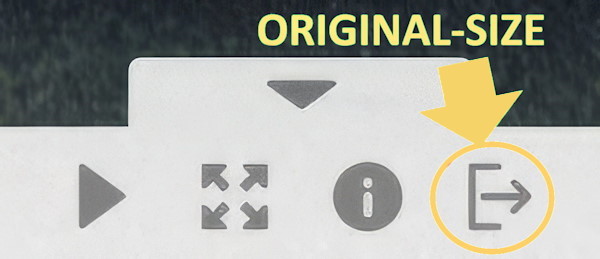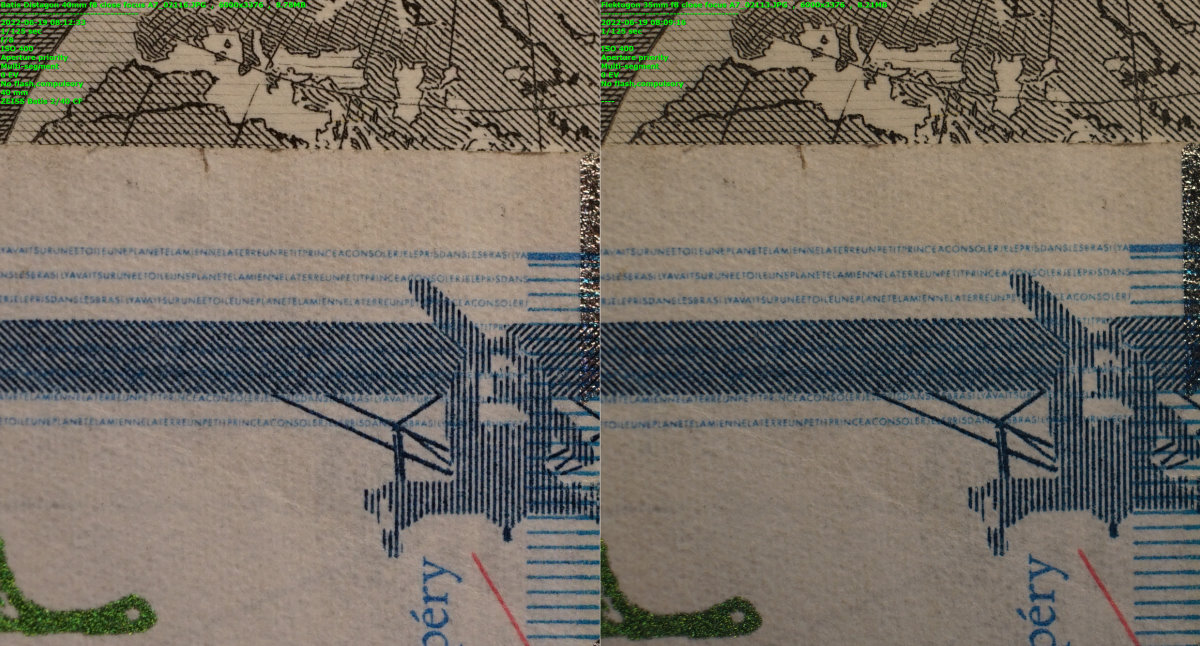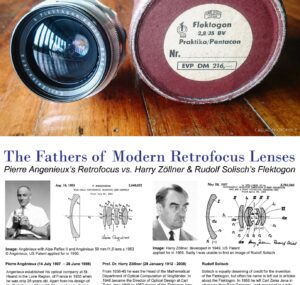
There are a few good reasons to compare these two lenses
- Zeiss’ modern Distagon lens design is historically linked to Carl Zeiss Jena East Germany’s Flektogon retrofocus lens design from the early 1950s. The retrofocus lens is an important step in the history of lens design innovations because it made wide-angle lenses possible for SLR cameras. In the 1940s, the challenge was to design a lens where the light rays would pass through the tunnel with the camera’s mirror and still get an image with a wide angle of view. The retrofocus lens design is ideal for mirrorless digital cameras due to the light rays incident almost at right angles on the sensor. A property that wide angle biogon lenses unfortunately do not have, which are more suited for film cameras where the angle of light rays incident does not matter.
- Despite its name, the legendary Flektogon 35mm classic lens (also called “The Flek“) actually has a 37mm focal length. (The licensed Russian copy of the Flektogon lens is the MIR-1B 37mm f/2.8 lens. Note the correct 37mm label in the name. Its lens has the same angle of view as the Flektogon lens.) Therefore, because there is only a focal length difference of 3mm between the Distagon (40mm) and the Flektogon (37mm) lenses under review, a direct comparison is possible.
- Both lenses are characterized by good close focusability, which is expressed by the “CF mark” for close focus on the Batis Distagon lens. Not all Flektogon 35mm lenses have the close focus capability; only some Zebra or later versions support that feature. Interested? Look at the information under the heading “Close focus, a touch of macro photography?“.
Don’t be surprised about the yellowish images taken with the Flektogon 35mm lens. The lens seems to use a type of glass containing thorium, which is known for its high refractive index but is prone to yellowing when stored in the dark. By developing the images from RAW files, this coloration can be completely neutralized. For the comparison photos below I intentionally kept the yellowish coloring for easy destinction between the modern Batis Distagon and classic Flektogon lens.
Carl Zeiss in West Germany created the new registered brand name Distagon after World War II to distinguish its retrofocus lenses from Carl Zeiss Jena’s Flektogon in East Germany. The name Flektogon derives from the Latin flecto, meaning “bend or curve”, and the Greek γωνία (gonia), meaning “angle or corner”. The name Distagon derives from “distance”, and also from the Greek γωνία (gonia), which refers to the wide angle of view of this type of lens.
Some of the following comparison images were shot at Wasserburg am Inn (also known as the Venice of Bavaria). Wasserburg is a small medieval village east of Munich, Germany, nearly surrounded by the long, wide River Inn, which flows into the Danube.
When you click on an image in the galleries, following buttons will allow you to select some features. Use Original-size to watch the photo in full resolution:

Slideshow | Fullscreen | Image-Info | Original-size
Check out the complete set of Distagon 40mm vs. Flektogon 35mm image quality comparison photos at aperture f/8, f/4 and f/2.8 shot in Wasserburg am Inn, southern Germany
To ‘pixel peep’, click on a photo between 1 and 12 to enlarge it, then click the Original-size button to see the photo in full 24-megapixel resolution.
Check the center and corner sharpness of the Distagon 40mm and Flektogon 35mm lenses
At aperture f/2.8, the Zeiss Batis Distagon 40mm lens is far superior in image quality, but at aperture f/8, the classic Flektogon 35mm lens shows a surprisingly good image quality in the center and corners, especially for such an old lens.
Photos of the Zeiss Batis Distagon 40mm vs. Carl Zeiss Jena Flektogon 35mm lenses shot in Maxlrain, at the largest vintage car event in southern Germany
Shining chrome and noble sheet metal from all eras of automotive history. After a two-year break due to the coronavirus disease pandemic, the Maxlrain vintage car event took place again in June 2022, not far away from Wasserburg am Inn. The event around Maxlrain castle, located about 50km southeast of Munich, Germany, is the largest vintage car meet in southern Germany.
Almost all photos from the vintage car event are taken with the modern Batis Distagon 40mm f/2 and classic Flektogon 35mm f/2.8 lenses:
Some more photos from the same vintage car event at the Maxlrain castle. These photos are 1-to-1 comparison photos of the modern Batis Distagon 40mm f/2 (left) and classic Flektogon 35mm f/2.8 (right) lenses:
Close focus, a touch of macro photography?
Let’s calculate the macro magnification factor of both lenses. The Batis Distagon image below shows approx. 114mm of the inch bar. Dividing that by 36mm full format sensor width results in a macro magnification factor of approx. 1:3.2. The Flektogon image below shows 75mm of the inch bar. Again, dividing that by 36mm full format sensor width results in a macro magnification factor of approx. 1:2.1. Suprising observation: With the Flektogon, you can shoot objects that are only 7cm away from the front lens.
Do you know about the secret message on the old French 50-francs banknote?

A secret microprint message is located in the uppler left part of France’s old 50-franc bank note. It is seemingly a string of random letters: RISDANSLESBRASILYAVAITSURU and so on (click on image to enlarge). However, the letters are not at all random. It turns out to be an excerpt from author Antoine de Saint-Exupéry’s cult novel The Little Prince, repeated over and over, with all spaces and punctuation removed.
It says, “Il y avait sur une étoile, une planète, la mienne, la Terre, un petit prince à consoler! Je le pris dans les bras.” Translated into English, it says, “It was necessary, on a star, a planet, on mine, here on earth, to comfort a little prince! I took him in my arms.”
I would say that both lenses are somewhat on par when zoomed into the same image detail. What is your view? Don’t hesitate to leave a comment below the article.
Rundown
This article is still in the draft stage. My preliminary conclusions on the Distagon and Flektogon lenses are as follows:
- The classic Flektogon 35mm lens: at aperture f/8 on the Sony a7ii full frame camera shows a surprisingly good image quality in the center and in the corners for such an old lens. Nevertheless, strong chromatic aberrations appear in the corners and the coloring and contrast must be corrected when developing the RAW files.
- The Zeiss Batis Distagon 40mm f/2 lens: is far superior in image quality. The Batis Distagon shines in all the relevant disciplines that make up a good lens: very good sharpness in the center and corners even at open aperture f/2; nice creamy bokeh; almost no chromatic aberrations and flares; beautiful color reproduction; and super-fast and precise autofocus. The only thing I missed was an aperture dial right on the lens. For me, as a bokeh aficionado, it was cumbersome to constantly change the aperture via small dials on the camera. Chapeau Zeiss! This Batis Distagon lens with the quite universal focal length of 40mm is the incarnation of an almost “perfect lens” for me.
- Street photography with subject separation at f/2 at the Bosna Grill in Wasserburg (see below) would be impossible with the Flektogon 35mm because of the low image quality at f/2.8 and the lack of an f/2 aperture. Also, the fast autofocus of the Batis Distagon will capture the magic moments with a much higher success rate and do a nice object seperation with aperture f/2.
- Both lenses, the Batis Distagon 40mm and the classic Flektogon 35mm are suitable for use on a Sony a6100 camera with APS-C sensor. Due to the crop factor of 1.52, the angle of view is about the same as approx. 61mm and 56mm lenses on full frame (for the Flektogon take a real 37mm focal length x 1.52). The image quality of the Batis Distagon on the Sony a6100 APS-C camera is excellent even at open aperture f/2, while the Flektogon is somewhat ok between aperture f/4 and f/8.
- The new Zeiss Batis Distagon 40mm f2 lens is priced above EUR 1,000, while the Flektogon 35mm f/2.8 classic lens can be purchased for approx. EUR 150. The Russian copy of the Flektogon lens should be available below approx. EUR 100, but is lacking the close focus capabilities: https://www.pentaxforums.com.
Since so many were made from 1950 to 1990, the Flektogon 35mm lens is one of the cheapest Zeiss lenses you can buy. There is also a later version of this Flektogon 35mm lens with an aperture of f/2.4 from the late East Germany era, which received a multi-coating that improves image contrast and color rendition. Because of the legendary status of this Flektogon 35mm f/2.4 version, the prices rise beyond an acceptable level in my view. The Flektogon 35mm f/2.4 version also often suffers from worn out plastic parts of the inner lens mechanics.
Both lenses have a special challenge for close focus distances: the lenses close the aperture for a small step. That means that bokeh images in close focus sometimes show the shape of the aperture blades in the bokeh balls.
Wasserburg street photography and street food recommendation: Bosna Grill
If you find yourself in downtown Wasserburg am Inn, don’t miss the “Bosna Grill” (klick here for Google Maps location) for its spicy and delicious Balkan sausage with onions and parsley. You’ll find Bosna Grill near the city hall on the side of the Frauenkirche (Church of our Lady). Have a look at these street photos from the small but beautiful Wasserburg am Inn. A closer exploration of Wasserburg’s old town reveals many fascinating hidden corners — it perfectly embodies the saying the best things come in small packages. Thanks to Marlon for sharing some of his Wasserburg street photos and the friendly permission to publish the Bosna Grill photos.
.
Carl Zeiss Jena Flektogon 35mm Wide Angle Lens History
Read this excellent article by Cheyenne Morrison from Queensland, Australia. It’s about the Carl Zeiss Jena Flektogon 35mm Wide Angle Lens History and the inventors of the modern retrofocus lenses, Pierre Angenieux and Harry Zöllner. Click on the image to read the article.
THE FLEK: The legendary Carl Zeiss Jena Flektogon 35mm f/2.8 lens
Check out this informative video by Mark Holtze from the Greater Toronto Area, Canada. It’s about the history of the legendary Carl Zeiss Jena Flektogon 35mm f/2.8 lens. Click on the image to watch the video.

Was it wrong of me to burst out laughing when I saw the first wide open comparison shot with the Flektagon?